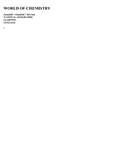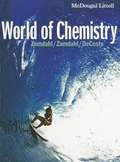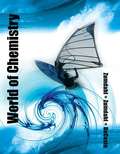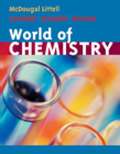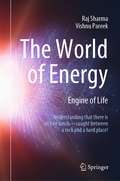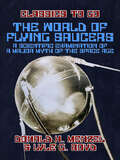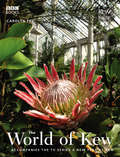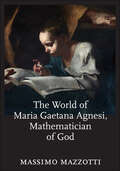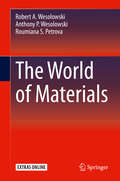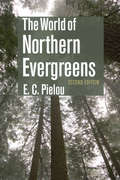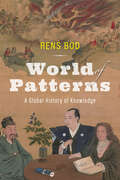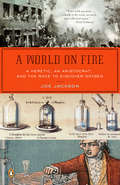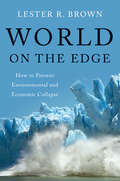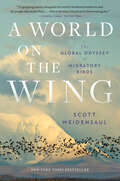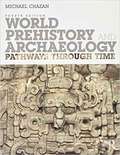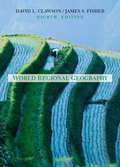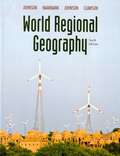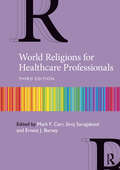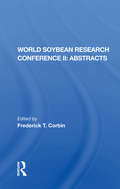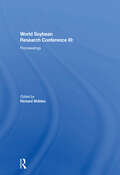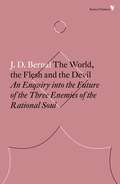- Table View
- List View
World Of Chemistry
by Steven S. Zumdahl Susan A. Zumdahl Donald J. DeCosteEasy to read and accessible to all students, WORLD OF CHEMISTRY includes National Geographic images and visuals, numerous problem-solving examples, a wide range of end-of-chapter exercises, and real world applications that truly bring the "world of chemistry" together in one unique central learning resource. Offering a rigorous but understandable introduction to chemistry, this program reflects the authors' belief that chemistry is something students must construct for themselves with the help of the teacher, content support including introductions to National Geographic Explorers, and laboratory exploration. This new 4th edition has been completely redesigned to include National Geographic images, Explorers, and the incorporation of new engineering features.
World of Chemistry: Easyplanner
by Steven S. Zumdahl Susan L. Zumdahl Donald J. DeCosteNIMAC-sourced textbook
World of Chemistry
by Steven S. Zumdahl Susan L. Zumdahl Donald J. DeCosteChemistry textbooks are written differently from non-technical textbooks. With this in mind, be aware that reading five pages in a chemistry textbook will probably take much more time than reading five pages in an English or a history textbook. If you want to understand this chemistry text, prepare to spend a great deal of time reading each section within a chapter. If you flip through this book, you will notice many examples, explanations, diagrams, charts, symbols, and photos to read, analyze, and interpret. You should read the text in each section and incorporate these visuals in your reading. You will quickly find that these visuals are very useful in helping you understand the subject matter.
World of Chemistry (Second Edition)
by Steven S. Zumdahl Susan L. Zumdahl Donald J. DecosteWorld of Chemistry presents the right balance of concepts and applications, emphasizing active learning and encouraging students to solve problems creatively.
The World of Energy: Engine of Life
by Raj Sharma Vishnu PareekThis book analyzes the entire spectrum of energy, from conventional sources to various alternative sources. Historically, the Sun has been viewed as the ultimate source of energy on the Earth. All forms of energy – fossil fuels and renewables alike – owe their existence to the Sun. The book also provides a historical perspective on energy policy over the years. It explains the fundamentals of energy and all related aspects using clear and straightforward language, and will serve as a reference guide for all stakeholders including policymakers, academics, students and world citizens in general.
The World of Flying Saucers A Scientific Examination of a Major Myth of the Space Age (Classics To Go)
by Donald H. MenzelExcerpt: "Both as scientists and as devotees of science fiction, we have long been interested in space travel. When reports of unidentified flying objects began to increase in the years between 1947 and 1952, one of us (D.H.M.) collected and studied the limited information available about the sightings. He soon concluded (with a slight feeling of disappointment!) that the flying saucers were not vehicles from other worlds but were only mundane objects and events of various kinds, some of them commonplace, some familiar chiefly to meteorologists, physicists, and astronomers."
The World of Kew
by Carolyn FryWithout plants, there would be no life on earth. Kew Gardens is famous for its breathtaking displays of flowers and tree,s but this World Heritage Site is also a globally important scientific and historical organization. Scientists and gardeners use the plants and knowledge that have been collected at Kew since the eighteenth century to advance understanding of the earth's environment and of how plant lfe can be used for human benefit. Published to accompany the ten-part BBC2 series A New Year at Kew, this fascinating book takes us behind the scenes to show the extraordinary range of work carried out at Kew Gardens and Wakehurst Place - home to the Millenium Seed Bank - and by Kew staff overseas. From using forensic botant to micropagating plants facing extinction, from investigating herbal cures from Alzheimer's disease to replanting the volcano-ravaged island of Montserrat, the book shows us aspects of Kew's work that are largely hidden from view abut the benefits of which are far reachingl In the process it provides an absorbing and accessible introduction to such topical subjects as biodiversity, practical conservation and economic botany. Lavishly illustrated and filled with engrossing stories and engaging characters, this book brings to life the world of Kew and the global importance of its work.
The World of Maria Gaetana Agnesi, Mathematician of God (Johns Hopkins Studies in the History of Mathematics #2)
by Massimo MazzottiThe fascinating true story of mathematician Maria Agnesi.She is best known for her curve, the witch of Agnesi, which appears in almost all high school and undergraduate math books. She was a child prodigy who frequented the salon circuit, discussing mathematics, philosophy, history, and music in multiple languages. She wrote one of the first vernacular textbooks on calculus and was appointed chair of mathematics at the university in Bologna. In later years, however, she became a prominent figure within the Catholic Enlightenment, gave up academics, and devoted herself to the poor, the sick, the hungry, and the homeless. Indeed, the life of Maria Agnesi reveals a complex and enigmatic figure—one of the most fascinating characters in the history of mathematics. Using newly discovered archival documents, Massimo Mazzotti reconstructs the wide spectrum of Agnesi's social experience and examines her relationships to various traditions—religious, political, social, and mathematical. This meticulous study shows how she and her fellow Enlightenment Catholics modified tradition in an effort to reconcile aspects of modern philosophy and science with traditional morality and theology.Mazzotti's original and provocative investigation is also the first targeted study of the Catholic Enlightenment and its influence on modern science. He argues that Agnesi's life is the perfect lens through which we can gain a greater understanding of mid-eighteenth-century cultural trends in continental Europe.
The World of Materials
by Robert A. Wesolowski Anthony P. Wesolowski Roumiana S. PetrovaThe world of materials is exciting because new materials are evolving daily. After an introduction to materials science, the book addresses the classification and structure of matter. It moves on to discuss crystal and mechanical properties. Next, the book employs various materials such as semiconductors and iron wires to teach concepts such as electrical conductivity, heat conductivity and allotropes. Corrosion is addressed and a chapter dedicated to interpretation of graphs and diagrams in materials science is presented. The book then progresses with chapters on ceramics, biomaterials, polymers and composites. To address the growing importance of recycling materials, polymer identification codes are explained. Interesting topics such as accidental materials discovery and materials failure are included. Each chapter ends with a chapter summary and questions and answers. Illustrations and worked examples are provided throughout. A lab manual is included as well.Presents an broad overview of materials science topics, including such topics as: crystal and mechanical properties of materials, semiconductors and iron wires, corrosion, ceramics, biomaterials, polymers, and composite materials;Examines modern-day materials, their synthesis, properties, alteration, and applications;Includes supplemental material, such as a lab manual and examples.
The World of Northern Evergreens
by E. C. PielouPraise for the first edition—"This book is guaranteed to enrich the reader's next forest visit."—Library Journal"Pielou's book brings forest ecology to naturalists, bird lovers, hikers, cyclists, canoeists, skiers, mountaineers, and back-country campers."—Seattle Post-Intelligencer"It is E. C. Pielou's contention that evergreen forests... are taken for granted and rarely well understood. To remedy this, the distinguished biogeographer has written a book focusing on the northern evergreen forests. This is a book that many naturalists, both novice and experienced, will read with pleasure and interest."—Canadian Field-Naturalist "Pielou makes a strong, irrefutable, case for the preservation of old-growth forests and wilderness. Anyone who appreciates the outdoors should have this book and take its message to heart."—Forest Planning Canada Global warming and human-driven impacts from logging, natural gas drilling, mining of oil sands, and the development of hydropower increasingly threaten North America's northern forests. These forests are far from being a uniform environment; close inspection reveals that the conifers that thrive there—pines, larches, spruces, hemlocks, firs, Douglas-firs, arborvitaes, false-cypresses, junipers, and yews—support a varied and complex ecosystem. In The World of Northern Evergreens, the noted ecologist E. C. Pielou introduces the biology of the northern forests and provides a unique invitation to naturalists, ecologists, foresters, and everyone living in northern North America who wants to learn about this unique and threatened northern world and the species that make it their home. Through identification keys, descriptions, and life histories of the conifer tree species, the author emphasizes how different these plants are both biologically and evolutionarily from the hardwoods we also call "trees." Following this introduction to the essential conifers, the author's perceptive insights expand to include the interactions of conifers with other plants, fungi, mammals, birds, and amphibians. The second edition, enriched by new illustrations by the author of woodland features and creatures, updates the text to include new topics including mycorrhizal fungi, soil, woodlice, bats, and invasive insects such as the hemlock woolly adelgid. Emphasis is given to the very real human-driven impacts that threaten the species that live in and depend on the vital and complex forest ecosystem. Pielou provides us with a rich understanding of the northern forests in this work praised for its nontechnical presentation, scientific objectivity, and original illustrations.
World of Patterns: A Global History of Knowledge
by Rens BodA comprehensive account of the methods of knowledge production throughout human history and across the globe.The idea that the world can be understood through patterns and the principles that govern them is one of the most important human insights—it may also be our greatest survival strategy. Our search for patterns and principles began 40,000 years ago, when striped patterns were engraved on mammoths' bones to keep track of the moon's phases. What routes did human knowledge take to grow from these humble beginnings through many detours and dead ends into modern understandings of nature and culture? In this work of unprecedented scope, Rens Bod removes the Western natural sciences from their often-central role to bring us the first global history of human knowledge. Having sketched the history of the humanities in his ground-breaking A New History of the Humanities, Bod now adopts a broader perspective, stepping beyond classical antiquity back to the Stone Age to answer the question: Where did our knowledge of the world today begin and how did it develop? Drawing on developments from all five continents of the inhabited world, World of Patterns offers startling connections. Focusing on a dozen fields—ranging from astronomy, philology, medicine, law, and mathematics to history, botany, and musicology—Bod examines to what degree their progressions can be considered interwoven and to what degree we can speak of global trends.In this pioneering work, Bod aims to fulfill what he sees as the historian's responsibility: to grant access to history's goldmine of ideas. Bod discusses how inoculation was invented in China rather than Europe; how many of the fundamental aspects of modern mathematics and astronomy were first discovered by the Indian Kerala school; and how the study of law provided fundamental models for astronomy and linguistics from Roman to Ottoman times. The book flies across continents and eras. The result is an enlightening symphony, a stirring chorus of human inquisitiveness extending through the ages.
The World of the Beaver
by Leonard Lee Rue III"According to a Cherokee legend," writes Leonard Lee Rue in The World of the Beaver, "it was the Great Spirit, with the help of gigantic beavers, who created the earth. The earth had been covered with water until the Great Spirit sent the beavers diving down beneath the surface to dredge up mud from the bottom to form land masses." Although the beaver is not, nowadays, as big as his legendary ancestors, he continues to be enormously helpful to man and beast. Here Leonard Lee Rue reveals the world and way of life of the good -natured, industrious American beaver and follows him through a full year of his ordinary activities. How does a beaver fell a tree? What does he eat? Is he polygamous or monogamous? How does he build a dam? What does the inside of his lodge look like? Who has been his most deadly enemy in America? The author-whose interest in beavers has caused him to go swimming with them and, on one occasion, led to his becoming stuck in the passage to a lodge-answers all these questions and many others. The informal narrative and the author's remarkable photographs make this really first-rate reading for the nature student and for the ordinary reader. "As intent as man seems to be on destroying the earth," writes Leonard Lee Rue in conclusion, "the Creator may again have to call upon the beavers to help patch things up. The earth's future couldn't be in better paws."
The World of the Gull (A Living World Book)
by David F. CostelloThe world of the gull extends from the barren Arctic wastes to the burning sands of Arabia, from the storm clouds of Tierra del Fuego to the farmlands of our own Great Plains. Equipped with extraordinary flying ability, intelligence, and an enviable digestion, gulls lead strange and wonderful lives. Born opportunists, they are completely adaptable, self-sufficient creatures, equally at home on land or sea-one of the few members of the animal kingdom able to drink both fresh and salt water. Unlike most other birds, gulls walk, fly, and swim with ease. These capabilities put them in touch with an unlimited variety of food-from cherries, mice, brine fly larvae, wheat, and steak bones to eggs, worms, and young ducks-and make them one of nature's most valuable scavengers. David Costello describes all aspects of the gulls' life cycle-their ritualistic courtship and nesting habits, the rearing of their young, colony formation, food finding, natural enemies, and their remarkable migrations over the face of the earth.
The World of the Otter (Living World Book)
by Ed ParkEver wondered how those otters on the river bank are so playful, what do they eat, where do they live, how do they survive the winter? In this book by naturalist Ed Park, who has studied otters for years, you will find the answers to these questions and get to know the clowns of the river bank more closely.
A World on Fire
by Joe JacksonThe discovery of oxygen in the late 1700s changed human thought & history radically. Yet its discovery began quietly, with the survival of a mouse under a lab. bell jar. This re-creation of these events takes us back to the final decades of the 1700s & the waning days of the Enlightenment. The English heretic & the French aristocrat who simultaneously isolated oxygen could not have been an unlikelier pair. Joseph Priestley was a tinkerer who knew Ben Franklin, John Adams, & Thomas Jefferson, to whose new nation he eventually fled. Antoine Lavoisier was rich & sophisticated, yet his path ended at the guillotine. Both Priestley & Lavoisier would see their works & lives destroyed, & never know how profoundly they changed the future. Illustrations.
World on the Edge: How to Prevent Environmental and Economic Collapse
by Lester R. BrownIn this urgent time, World on the Edge calls out the pivotal environmental issues and how to solve them now. We are in a race between political and natural tipping points. Can we close coal-fired power plants fast enough to save the Greenland ice sheet and avoid catastrophic sea level rise? Can we raise water productivity fast enough to halt the depletion of aquifers and avoid water-driven food shortages? Can we cope with peak water and peak oil at the same time? These are some of the issues Lester R. Brown skillfully distills in World on the Edge. Bringing decades of research and analysis into play, he provides the responses needed to reclaim our future.
A World on the Wing: The Global Odyssey Of Migratory Birds
by Scott WeidensaulNew York Times Bestseller Finalist for the Los Angeles Times Book Prize A Library Journal Best Science and Technology Book of the Year An exhilarating exploration of the science and wonder of global bird migration. In the past two decades, our understanding of the navigational and physiological feats that enable birds to cross immense oceans, fly above the highest mountains, or remain in unbroken flight for months at a stretch has exploded. What we’ve learned of these key migrations—how billions of birds circumnavigate the globe, flying tens of thousands of miles between hemispheres on an annual basis—is nothing short of extraordinary. Bird migration entails almost unfathomable endurance, like a sparrow-sized sandpiper that will fly nonstop from Canada to Venezuela—the equivalent of running 126 consecutive marathons without food, water, or rest—avoiding dehydration by "drinking" moisture from its own muscles and organs, while orienting itself using the earth’s magnetic field through a form of quantum entanglement that made Einstein queasy. Crossing the Pacific Ocean in nine days of nonstop flight, as some birds do, leaves little time for sleep, but migrants can put half their brains to sleep for a few seconds at a time, alternating sides—and their reaction time actually improves. These and other revelations convey both the wonder of bird migration and its global sweep, from the mudflats of the Yellow Sea in China to the remote mountains of northeastern India to the dusty hills of southern Cyprus. This breathtaking work of nature writing from Pulitzer Prize finalist Scott Weidensaul also introduces readers to those scientists, researchers, and bird lovers trying to preserve global migratory patterns in the face of climate change and other environmental challenges. Drawing on his own extensive fieldwork, in A World on the Wing Weidensaul unveils with dazzling prose the miracle of nature taking place over our heads.
World Prehistory And Archaeology: Pathways Through Time
by Michael ChazanWorld Prehistory and Archaeology: Pathways through Time, fourth edition, provides an integrated discussion of world prehistory and archaeological methods. This text emphasizes the relevance of how we know and what we know about our human prehistory. A cornerstone of World Prehistory and Archaeology is the discussion of prehistory as an active process of discovery. Methodological issues are addressed throughout the text to engage readers. Archaeological methods are introduced in the first two chapters. Succeeding chapters then address the question of how we know the past to provide an integrated presentation of prehistory. The fourth edition involves readers in the current state of archaeological research, revealing how archaeologists work and interpret what they find. Through the coverage of various new research, author Michael Chazan shows how archaeology is truly a global discipline.
World Regional Geography: A Development Approach (8th edition)
by David L. Clawson Merrill L. JohnsonThis book is organized around the central theme of human development. Each author employs the human development theme to create a substantive volume on world regional geography that presents a vital, issues-oriented overview of the topic.
World Regional Geography (10th edition)
by David L. Clawson Merrill L. Johnson Douglas L. Johnson Viola HaarmannPulling from an impressive team of ten authors, each chapter in this book has been authored by an expert in the region to provide the utmost accuracy and relevancy. World Regional Geography explores the character of the world's people, with a central theme of human development, for an issues-oriented overview of each region. An emphasis on subregions (places within regions) enables readers to explore specific locales. An economic development theme offers a more conceptual treatment than the traditional coverage of this topic. Basic Concepts and Ideas; The United States and Canada; Latin America and the Caribbean; Europe; Northern Eurasia; Central Asia and Afghanistan; The Middle East and North Africa; Africa South of the Sahara; South Asia; East Asia; Southeast Asia; Australia, New Zealand, and the Pacific Islands. The useful references for anyone who wants to learn more about the different regions of the world.
World Religions for Healthcare Professionals
by Mark F. Carr Siroj Sorajjakool Ernest J. BurseyThis third edition of a popular text introduces healthcare students and professionals to a wide range of health beliefs and practices in world religions. Chapters on various religions are written to offer an insider’s view on the religion’s historical development, key beliefs and practices, including ideas of health, sickness, death, and dying. The chapters include case studies, advice on what to do and what to avoid when caring for patients. Introductory chapters invite the reader to consider the broad context of patient care in pluralistic society and explore one’s personal orientation to others from different religions. How we care for patients from different backgrounds and cultures insists on professional boundaries that the reader may have not yet examined. A new chapter explores the relationship between religion and public health in light of the COVID-19 pandemic, asking the reader to consider what morally appropriate balance is required if and when personal faith conflict with public health needs. Undoubtedly, the sensitivity with which clinicians communicate with patients and make decisions regarding appropriate medical intervention can be greatly increased by an understanding of religious and cultural diversity. This is a core textbook for students studying healthcare, religion and culture, and an invaluable reference for healthcare professionals.
World Soybean Research Conference Ii, Abstracts
by Frederick T CorbinThe result of strong international interest in the soybean, the World Soybean Research Conference II was held March 26-29, 1979, at North Carolina State University. This volume contains summaries of the more than two hundred papers presented at that meeting. The authors, international authorities in their fields, represent sixteen areas of professi
World Soybean Research Conference III: Proceedings
by Richard ShiblesThis volume consists of full length manuscripts of 159 of the 165 invited papers presented at World Soybean Research Conference III that was held in the Scheman Continuing Education Building at Iowa State University August 12-17, 1984. The authors, widely recognized as world authorities in their fields, represent all aspects of soybean research activity: breeding and genetics, crop and soil management, economics, entomology, food science, international programs, nematology, pathology, physiology, plant nutrition, rhizobiology, utilization, and weed science. This proceedings, which contains more than 1200 pages of information including many tables and figures, represents the most extensive compilation of soybean research results since the previous proceedings were published in 1980. It should be of value to research scientists, students and administrators alike.
The World, the Flesh and the Devil: An Enquiry into the Future of the Three Enemies of the Rational Soul
by J. D. BernalA pioneering book proposing a transhumanist vision of the future, from one of the most influential visionary scientists of the twentieth century.
